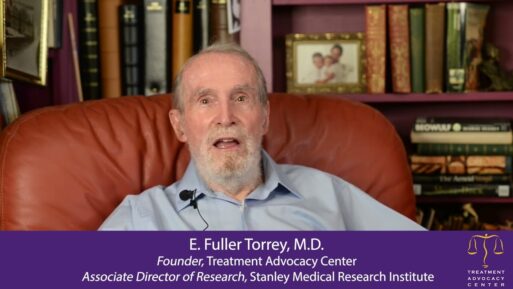
Dr. E. Fuller Torrey calls for more funding for Parkinson’s Disease
(10-31-23) For decades Dr. E. Fuller Torrey, the founder of the Treatment Advocacy Center and a tireless advocate for better health care, has argued that the federal government should better fund mental health research. Now, at age 86, he is calling for more federal research into the causes and potential cures for Parkinson Disease. In this article, first published by The Washington Monthly, he describes how the disease is affecting him and points out the disparity between funding for Alzheimer’s research and Parkinson.
Reprinted with author’s permission.
My Parkinson’s Crisis—And Ours
The still-mysterious disease is spreading wildly, and Washington isn’t doing enough. As a physician and a sufferer, I should know.
Parkinson’s disease is a puzzle. I know because I have had it for more than a decade. Some of its symptoms, such as tremors, are easy to understand, but others are weird. For example, turning my body is difficult, and it’s even more difficult if I try to turn it clockwise rather than counterclockwise. I have lost my ability to swim. And what happens when I suddenly freeze, as if my feet were glued to the floor? My brain has sent a message to my feet to step forward. Did the message not arrive, or did my feet simply ignore it? It’s impossible to know. (This article has a shared byline, but the “I” refers to Torrey.)
Parkinson’s disease is not just a puzzle; it’s an expensive one. A recent detailed study, based on 2017 data, reported that just over 1 million individuals in the United States were living with Parkinson’s. The disease costs our health care system $51.9 billion annually—and that price is expected to balloon to $79.1 billion by 2037, or roughly $1.36 billion a year. Since 90 percent are 65 or older, these patients place a particularly heavy burden on Medicare.
Even more alarming, the researchers estimated that by 2037 an additional 600,000 people will be diagnosed with Parkinson’s. Such projections are consistent with other studies showing that Parkinson’s is the fastest-growing neurological disease globally, increasing even faster than Alzheimer’s disease. Indeed, an editorial in The Lancet Neurology reported that “the prevalence, burden of disability, and number of deaths associated with Parkinson’s disease all more than doubled between 1990 and 2016.” Some observers call this a “Parkinson’s pandemic.”
Part of this increase is attributable to people living longer and to the large, aging Baby Boomer population. But that is only a partial explanation. Another part might be due to factors related to the causes of this disease. Studies have shown that you are more likely to get Parkinson’s if you have red hair or melanoma, or if you still have your appendix. Other studies have reported that having numerous dental amalgam fillings or living downwind from a golf course are risk factors. Perhaps strangest is data showing that drinking large amounts of milk or never having smoked tobacco increases your chances of getting Parkinson’s disease. Examining some of the leading theories of causation—genetics, infection and inflammation, toxic metals, and pesticides—can illuminate this puzzling potpourri of claims and determine whether research dollars are being effectively deployed in halting the rise of the disease.







